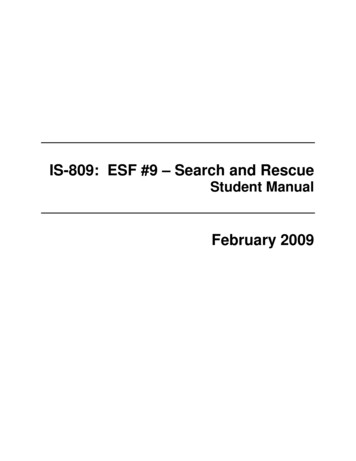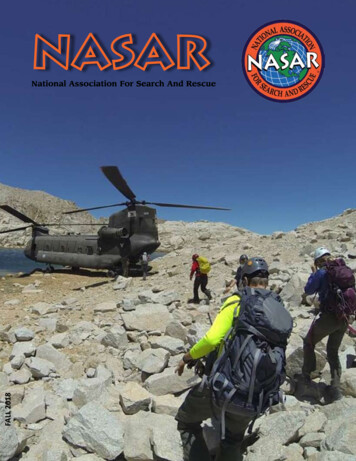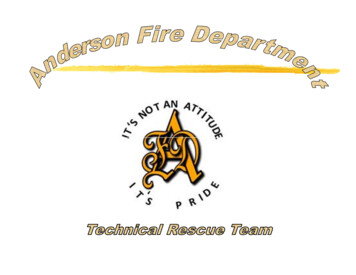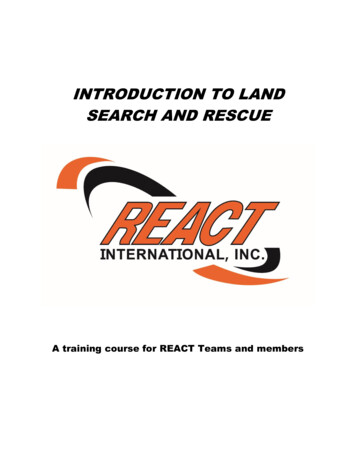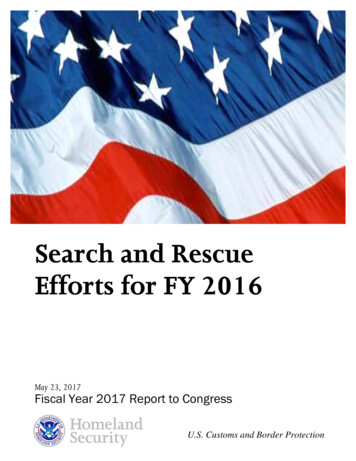
Transcription
Search and RescueEfforts for FY 2016May 23, 2017Fiscal Year 2017 Report to CongressU.S. Customs and Border Protection
Executive SummaryCBP components strive each day to secure our Nation’s borders at and between the ports ofentry. Securing our borders is our top priority. Security missions, however, often give way torescue missions because of harsh environmental conditions. CBP is searching constantly forways to address these challenges either through equipment and/or policy and programimplementation. To alleviate these challenges, CBP’s U.S. Border Patrol has several programsand initiatives focused on increasing border safety and minimizing the risk of migrant deaths.ii
Search and Rescue Effort for FY 2016Table of ContentsI.Legislative Language . 1II.Background . 2III.Data Report . 3IV. Discussion .A. Methodology .B. Identification of Deceased Individuals .C. Costs Associated with Search and Rescue Efforts .D. Costs Associated with the Identification, Return/Transfer, and Notification ofDeceased .E. Reducing Border Crossings and Deaths in Remote Areas.V.777888Conclusion . 9VI. Appendix - List of Acronyms . 10iii
I.Legislative LanguageThis document was compiled pursuant to the legislative language set forth in HouseReport 114-668 accompanying the Fiscal Year (FY) 2017 Department of Homeland Security(DHS) Appropriations Act (P.L. 115-31).House Report 114-668 states:CBP is directed to provide a report on its search and rescue activities during fiscalyear 2016 within 60 days of enactment of this Act, as detailed in HouseReport 114–215. In addition, the report should address, to the extent possible, thecause of death for each migrant and the federal costs related to search and rescueefforts, including any costs related to the identification of deceased individuals;the return or transfer of remains; and the notification of family members.House Report 114-215, which accompanies the FY 2016 DHS Appropriations Act(P.L. 114-113), states:The Committee commends CBP’s search and rescue efforts, in particular theBorder Patrol Search, Trauma, and Rescue (BORSTAR) Unit, and encouragesCBP to expand its engagement with State and local counterparts andnongovernmental organizations in providing necessary medical aid and reducingdeaths. Within 60 days of the date enactment of this Act, CBP shall provide areport to the Committee on its search and rescue efforts during the prior fiscalyear, including the number of deaths by sector and a description of themethodology for counting such deaths; the number of rescue beacons by sector;the frequency of rescue beacon activation; and the number of individuals rescuedby the Border Patrol as a result of rescue beacons. In addition, the briefing shouldaddress procedures for the identification of deceased individuals, cooperativeactivities with State and local governments and nonprofit organizations,procedures for responding to rescue beacons, distress calls, and missing personsreports, and plans for reducing border crossings and deaths in remote areas alongand near the border.1
II. BackgroundThe United States Border Patrol (USBP) created the Border Patrol Search, Trauma, and Rescue(BORSTAR) Unit in 1998 in response to the growing number of injuries to Border Patrol agentsand migrant deaths along our Nation’s borders. BORSTAR is located at the USBP’s SpecialOperations Group Headquarters in El Paso, Texas, and among USBP sectors.BORSTAR provides specialized law enforcement, search and rescue response from conventionalto high-risk Border Patrol Operations, Federal Emergency Management Agency missionassignments, national search and rescue operations, national special security events, andspecialized training support that DHS directs for both domestic and foreign governmentagencies. BORSTAR is the only national law enforcement search and rescue entity with thecapability to conduct tactical medical and search and rescue operations, and training for federal,state, local, and international government agencies. Since the inception of BORSTAR in 1998,the unit has evolved and enhanced its capabilities to fulfill the missions of DHS, U.S. Customsand Border Protection (CBP), and USBP, both foreign and domestic.On a national level, BORSTAR is located strategically to deploy rapidly throughout the UnitedStates. As part of Sector Special Operations Detachments, BORSTAR supports the 2012–2016Border Patrol Strategic Plan by conducting intelligence-driven operations to target transnationalcriminal organizations, high-risk areas, and crossborder criminal activity. BORSTAR iscomposed of experienced Border Patrol agents selected from all USBP sectors to complete theBORSTAR Selection and Training Course successfully.The BORSTAR Selection and Training Course is a physically and mentally demanding course inwhich candidates are evaluated in various search and rescue techniques, tactical medicine,technical rescue, land navigation, communication, swift-water rescue, air operations, and theability to work in a cohesive unit. Upon completion of the BORSTAR Selection and TrainingCourse, BORSTAR agents receive additional advanced specialized training in emergencymedical; tactical medicine; technical rope rescue; paramedic; austere medic; load planner;helicopter rope suspension training; rescue watercraft/boat operator; cold-weather operations;personnel recovery; small unit tactics; tactical combat casualty care; operations management andplanning; and advanced dive, swift-water, and technical rope rescue operations.2
III. Data ReportThe table below outlines USBP’s search and rescue efforts during FY 2016, including thenumber of deaths by sector.Search and Rescue Efforts by Sector (FY 2016)Rio Grande SectorNumber of searchesNumber of rescuesCost associated for search and rescue effortsNumber of deathso Environmental Exposure –Heat 42o Skeletal Remains 27o Water-Related 26o Undetermined 25o Other 4o Motor Vehicle-Related 3o Environmental Exposure – Cold 2o Train-Related 1Costs associated to identification, return/transfer, and notification of deceasedTucson SectorNumber of searchesNumber of rescuesCost associated for search and rescue effortsNumber of deathso Environmental Exposure – Heat 35o Skeletal Remains 12o Water-Related 0o Undetermined 7o Other 30o Motor Vehicle-Related 0o Environmental Exposure – Cold 0o Train-Related 0Costs associated to identification, return/transfer, and notification of deceasedYuma SectorNumber of searchesNumber of rescuesCost associated for search and rescue efforts3N/A1,377Not Tracked130Not TrackedN/A1,409Not Tracked84Not Tracked1718Not Tracked
Number of deathso Environmental Exposure – Heat 1o Skeletal Remains 0o Water-Related 1o Undetermined 3o Other 1o Motor Vehicle-Related 2o Environmental Exposure – Cold 0o Train-Related 0Costs associated to identification, return/transfer, and notification of deceasedEl Paso SectorNumber of searchesNumber of rescuesCost associated for search and rescue effortsNumber of deathso Environmental Exposure – Heat 3o Skeletal Remains 0o Water-Related 5o Undetermined 0o Other 0o Motor Vehicle-Related 1o Environmental Exposure – Cold 0o Train-Related 0Costs associated to identification, return/transfer, and notification of deceasedSan Diego SectorNumber of searchesNumber of rescuesCost associated for search and rescue effortsNumber of deathso Environmental Exposure – Heat 0o Skeletal Remains 3o Water-Related 2o Undetermined 1o Other 1o Motor Vehicle-Related 0o Environmental Exposure – Cold 0o Train-Related 0Costs associated to identification, return/transfer, and notification of deceased48Not Tracked4721Not Tracked9Not Tracked7847Not Tracked7Not Tracked
El Centro SectorNumber of searchesNumber of rescuesCost associated for search and rescue effortsNumber of deathso Environmental Exposure – Heat 1o Skeletal Remains 1o Water-Related 6o Undetermined 0o Other 0o Motor Vehicle-Related 1o Environmental Exposure – Cold 0o Train-Related 0Costs associated to identification, return/transfer, and notification of deceasedLaredo SectorNumber of searchesNumber of rescuesCost associated for search and rescue effortsNumber of deathso Environmental Exposure – Heat 17o Skeletal Remains 0o Water-Related 15o Undetermined 24o Other 2o Motor Vehicle-Related 8o Environmental Exposure – Cold 2o Train-Related 0Costs associated to identification, return/transfer, and notification of deceasedDel Rio SectorNumber of searchesNumber of rescuesCost associated for search and rescue effortsNumber of deathso Environmental Exposure – Heat 9o Skeletal Remains 0o Water-Related 5o Undetermined 2o Other 0o Motor Vehicle-Related 0o Environmental Exposure – Cold 0o Train-Related 0Costs associated to identification, return/transfer, and notification of deceased51336Not Tracked9Not Tracked1081,018Not Tracked68Not Tracked2436Not Tracked16Not Tracked
Big Bend SectorNumber of searchesNumber of rescuesCost associated for search and rescue effortsNumber of deathso Environmental Exposure – Heat 0o Skeletal Remains 0o Water-Related 0o Undetermined 2o Other 0o Motor Vehicle-Related 0o Environmental Exposure – Cold 0o Train-Related 0Costs associated to identification, return/transfer, and notification of deceasedGrand Forks SectorNone for FY 2016Swanton Sector 1None for FY 2016Havre SectorNone for FY 2016Miami SectorNone for FY 2016New Orleans SectorNone for FY 2016Ramey SectorNone for FY 2016Buffalo SectorNone for FY 2016Houlton SectorNone for FY 2016Detroit SectorNone for FY 2016Spokane SectorNone for FY 20161744Not Tracked2Not TrackedN/AN/AN/AN/AN/AN/AN/AN/AN/AN/A1Swanton, Havre, Miami, New Orleans, Ramey, Buffalo, Houlton, Detroit, and Spokane sectors are all eithercoastal or northern border sectors, which do not have rescue beacons and/or no rescues were registered in thesesectors in FY 2016. The appropriate data fields are thus marked “N/A.”6
IV. DiscussionA. MethodologyBorder-related deaths are tracked in the Border Safety Initiative Tracking System (BSITS),which USBP funds and manages. BSITS establishes a client-server database that serves as thecentral repository through web-based applications for collecting, managing, and disseminatingcritical incident data related to suspected, undocumented migrant deaths and Border Patrolrescues in selected counties along the U.S. border with Mexico. The data are used for analyzingthe number and locations of deaths and rescues, categorizing deaths and rescues, identifyingtrends, and identifying high-risk areas. Key USBP field and headquarters planners also use thedata in the budget planning process for allocating resources for border safety-related projects andmeasuring the effectiveness of other programs and projects.A border-related death is defined as a suspected, undocumented migrant: 1) while in furtheranceof an illegal entry; 2) within a designated target zone whether or not the Border Patrol wasdirectly involved; and/or 3) outside the designated target zone when the Border Patrol has directinvolvement with the incident.Once the medical examiner/coroner determines the cause of death, a suspected cause of death iscited in BSITS and is categorized as: Environmental Exposure – HeatEnvironmental Exposure – ColdMotor Vehicle AccidentWaterOtherB. Identification of Deceased IndividualsUSBP notifies law enforcement and the coroner’s office within the jurisdiction of the locateddeceased individual. Local law enforcement conducts an appropriate death-related investigationand the county coroner assumes responsibility for the deceased. USBP contacts the coroner’soffice to request cause of death and identity determination. USBP contacts the consulate officeof the deceased individual’s native country for notification.Tucson, Laredo, and Rio Grande Valley Sectors have established a full-time Missing MigrantInitiative (MMI), dedicating USBP personnel and resources to the identification, return/transfer,and notification of the deceased.The MMI works with foreign consulates; other federal agencies; state, local, and tribalauthorities; nongovernmental organizations; and families to locate and identify missing andsuspected deceased undocumented aliens and to offer their families the opportunity to claim theirremains. The MMI serves as an information clearinghouse for third-party reports of migrants7
who are missing or deceased. The MMI is an outgrowth of the Border Safety Initiative, whichseeks to save the lives of migrants when they find themselves in peril.C. Costs Associated with Search and Rescue EffortsUSBP Special Operations Group, Border Patrol Search, Trauma, and Rescue Unit (USBP SOGBORSTAR) allocates funding for Search and Rescue Operations (including training, equipment,and travel) annually and supports USBP sectors with search and rescue operations. For FY2016, USBP SOG BORSTAR budgeted and expended 1,584,215 in support of USBP searchand rescue operations.Currently, there is no system of record in place for USBP sectors to track costs associated withsearch and rescue efforts. USBP border security operational funding often is expended insupport of search and rescue operations within proximity to the U.S. borders.D. Costs Associated with the Identification, Return/Transfer, andNotification of DeceasedCurrently, there is no formal mechanism in place for USBP sectors to track costs associated withthe identification, return/transfer, and notification of deceased. USBP border securityoperational funding often is expended in the form of Border Patrol Agent work hours, salaries,benefits, and operational resources.E. Reducing Border Crossings and Deaths in Remote AreasUSBP has several programs and initiatives focused on increasing border safety and minimizingthe risk of migrant deaths.USBP contains more than 246 BORSTAR Unit agents who are trained and certified for advancedsearch and rescue operations. BORSTAR agents are located strategically along the Southwestborder and are on call and available to respond to high-risk emergent situations for extendedperiods.USBP medical initiatives provide emergency medical response training to agents throughout theentire border region specifically focusing on high-risk areas. USBP currently has more than1,200 certified Emergency Medical Technicians, as well as paramedics and first responders.USBP is proactive in providing public awareness through communicating the dangers of crossingthe Southwest border both within the United States and abroad. USBP complements the DHSmedia campaign plan to reach out to potential migrants in their home countries to discouragethem from attempting to enter the United States illegally.USBP also has 85 active rescue beacons strategically placed throughout the Southwest border, tosave the lives of illegal aliens in distress.8
V. ConclusionCBP will continue to secure our Nation’s borders at and between our ports of entry, and toprovide robust search and rescue response capabilities to mitigate risk in remote and austereenvironments. CBP will continue to develop innovative ways to address these challenges withequipment and through policy and program implementation.9
Appendix- List of AcronymsAcronymBORSTARBSITSCBPDHSFYMMIUSBPUSBP SOG BORSTARDefinitionBorder Patrol Search, Trauma, and RescueBorder Safety Initiative Tracking SystemU.S. Customs and Border ProtectionDepartment of Homeland SecurityFiscal YearMissing Migrant InitiativeU.S. Border PatrolU.S. Border Patrol, Special Operations Group, Border PatrolSearch, Trauma, and Rescue Unit10
CBP is directed to provide a report on its search and rescue activities during fiscal year 2016 within 60 days of enactment of this Act, as detailed in House Report 114-215. In addition, the report should address, to the extent possible, the cause of death for each migrant and the federal costs related to search and rescue
